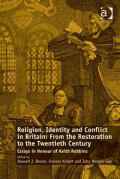When accepting the role of a reviewer, one is always pressed to ask: to what use is a book? To which audience is it addressed? What is its purpose? What scholarly gap does it fill? In this particular case, the answer is not obvious. Edited books have a tendency to be eclectic and uneven. Religion, Identity, and Conflict in Britain is no exception. The essays were published in honor of Keith Robbins, the celebrated author of The World Since 1945: A Conise History. The first chapter, written by Bruce Collins, is dedicated to a vivid exploration of his work. The last section comprises a select bibliography of his publications. In between no one pays any interest to Keith Robbins’s oeuvre. All contributors but two (with only one reference each) do not even cite him once. It is therefore not evident to acknowledge how Robbins has influenced the distinctive approaches and contributions favored by the various contributors, and how their findings confirm, refine, or refute the eminent historian’s conclusions. This neg-lect is surprising in a Festschrift.
The introduction penned by Stewart J. Brown, Frances Knight and John Morgan-Guy tries very hard to present in a coherent fashion the essays assembled in the book. Yet, it is difficult to understand why Peter Borsay’s paper on «the elites and the political landscape of the English town» finds itself in the section titled «Religion and Identity»; or why Brian Harrison’s paper on the Oxford History of England series is placed in the section titled «Conflict and Identity». Religion is certainly a thread common to most chapters, but by itself, it hardly justifies the juxtaposition of essays on «public somnolence in Eighteenth-century Britain», on the one hand, and «religion, politics and sport in Western Europe (1870–1939)», on the other.
The amalgam of the various essays in the book’s cornucopia is unfortunate because most contributions are very stimula-ting. I shall not offer a summary of each chapter (the editors provide wellhoned summaries in their introduction) but I will try to indicate how Religion, Identity, and Conflict in Britain might, notwithstanding its flaws, set out a frame for future historical studies on religion and society. I shall briefly underline not what the book achieves but what could have been achieved if the various contributions had been colleted with a clearer purpose.
First, the book could have provided an opportunity to reflect on possible comparisons with similar religious phenomena occurring in Europe and the Americas. For example, Paula Yates’ chapter on Welsh nationbuilding in the second half of nineteenth century cannot but raise interesting comparisons with the entanglement of faith and nationality elsewhere in the world. Secondly, Religion, Identity, and Conflict in Britain might have fuelled an understanding of religion that acknowledges the profound social and political permeability of Christianity. For everyday believers, religion does not first and foremost take place in churches; it happens in «halfway houses» (Brian Harrison) where Christian association is constantly negotiated. Frances Knight’s illuminating chapter on the episcopal interventions in the drink question in the 1890s shows how temperance was incorporated in the Christian ethos and yet, in the end, how the temperance movement subtly contributed to the demise of the Church’s social functions. Thirdly and finally, Religion, Identity, and Conflict in Britain may lead us to reflect on the relation between popular and highbrow cultures. For example, D. W. Bebbington’s essay on Evangelicanism and British culture explores the intertwinement of intellectual (empiricism, pragmatism) and religious beliefs, while Hugh McLeod’s essay deals with the religious investment of leisure activities, more specifically sports, of a rising and growing middle class.
If there is a lesson learned from reading some of the individual chapters, it is that (a) transnational studies (b) focusing on nonreligious objects invested by religious beliefs and institutions, and (c) opened to the inclusion of historical material coming both from popular and intellectual sources, may be the best way to renew our writing of religious histories. If it had focused on one of these aspects and stuck to it, the publication of Religion, Identity and Conflict in Britain could have constituted a valuable contribution to the field. But, as the French proverb goes, «qui trop embrasse mal étreint», which can be freely translated as: «An edited book should not bite off more than it can chew.»
Zitierweise:
Jean Philippe Warren: Rezension zu Stewart J. Brown/Frances Knight/John Morgan-Guy (Ed.), Religion, Identity and Conflict in Britain: From the Restoration to the Twentieth Century, Farnham, Ashgate, 2013. Zuerst erschienen in: Schweizerische Zeitschrift für Religions und Kulturgeschichte, Vol. 108, 2014, S. 526-527.
